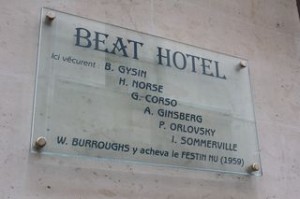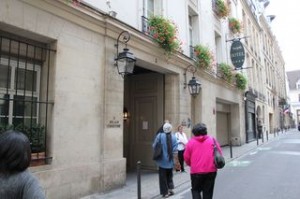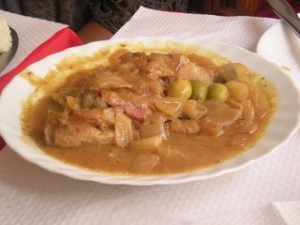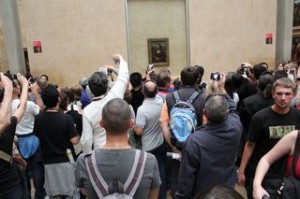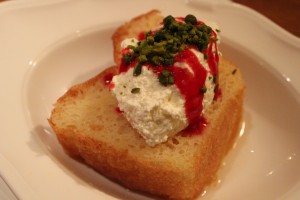We were standing at the fountain in Saint Michel, trying to make out the violent, yet strangely romantic scene of an angel that we took for Saint Michel slaying a horned demon, when Ealy Mays of Walking the Spirit Tours walked up. Ealy looks the way I would imagine a black ex-pat living in Paris to look. He wears a bibbed knit cap over his locs, which hang down his back and he’s carrying a large orange ceramic cup of coffee. It’s clear that he his comfortable in this city and very familiar with the narrow streets of the Latin Quarter. He starts with an important event in American Black History in Paris, the arrival of Sally Hemings, Thomas Jefferson’s slave mistress, which was followed by the arrival of Josephine Baker, black soldiers in World War I and II, and the BeBoppers. Ealy appears to be a fountain himself, but one of black history in Paris. As we meander through the Latin Quarter, he points out places where African-American writers, artists and performers sought refuge from American racism, places to just be themselves and practice their craft. Standing in front of the Relais Hotel du Vieux Paris, formerly known as the Beat Hotel, Ealy tells us that black detective writer Chester Himes once lived there. Himes penned “A Rage in Harlem,” which was rediscovered and became a movie starring Forest Whittaker and Robin Givens in the 90s. But Ealy also tells us how he is in a bit of a feud with the hotel owner because he wants to have Himes recognized here. He says he sometimes tapes Himes’ name on a plaque in front of the hotel listing other famed writers like Alan Ginsberg, who lived there too and became known as “beat” poets. He wants these black artists to get their due. At several trendy looking cafes, he tells us of how he has left pictures of famous black ex-pats on the walls, only to later find them removed. I am reminded of Spike Lee’s movie, “Do the Right Thing,” when Mookie asks why there aren’t any black people on the walls of Sal’s pizza shop. Ealy is kind of like the Mookie of Paris trying to do the right thing and keep the history of African Americans in Paris alive. Ealy also quizzes us periodically on our black history, “For 10 points, what was Josephine Bakers real name?” Answer: Freda Josephine McDonald. Josephine Baker and Richard Wright are the only two African Americans in Paris memorialized with a plaque in the city because they became Paris citizens, according to Ealy. He shares the little known back story on the tense relationship between Richard Wright and James Baldwin, suggesting the two didn’t get along well because Baldwin didn’t think Wright was black enough. These stories along with standing on Rue Christine in front of the hotel where Baldwin wrote much Giovanni’s Room, just down the street from where Gertrude Stein lived, brings these artists to life. We’d just had dinner on Rue Christine the night before at Chez Fernand and marvel that we were so close to so much black history. It seems that there is history around every corner in Paris, black or otherwise, and Ealy points out the Le Procope, restaurant founded in the 1600s that served the likes of Napoleon and early American leaders like George Washington and Thomas Jefferson. In fact, we see Napoleon’s pointy chapeau (hat) on display.
 Having received a pretty thorough introduction to the history of blacks in the Latin Quarter, we move to an entirely different scene to experience blacks in present day Paris. We hop on the 4 train and head north to Barbes-Rochechouart, the home of Paris’ West and North African community. As soon as we step off the metro, I feel like I am in Senegal. People crowd the corners of the street, entreating us to take a flyer or buy some trinket. But then it starts to resemble “the hood” in any American city with check cashing places and cheap mobile phone dealers lining the streets. We are having lunch here at a Senegalese restaurant, but before we even get there we see plain-clothed French cops in front of a Senegalese shop and we aren’t sure why. At La Niomre, it really feels like Senegal with the green and yellow Senegalese flag posted throughout and Muslim chants playing. Many of the people dining are Senegalese, so the food is certain to be traditional. I suggest Yassa, a lemon chicken dish with onions and olives, because it is the one I remember best from my travels in Senegal several years ago. April and I also have gingembre, a ginger drink that packs a punch. As we eat, we watch the people of Barbes-Rochechouart pass. Women in colorful African dress or some combination there of, heads wrapped or not. Some men wear kufi hats and some are in jelabas, the long robes of northern Africa. But April and my mother are best positioned to watch quite a scene unfold, where camera crews are trying to film inside a mosque, which doesn’t make the residents very happy and they’ve drawn a crowd. Later, Steve investigates out of curiosity and learns that the police have shut down the mosque just across the street from the restaurant and news crews are filming the incident. This must have been the start of what we saw when we arrived. We aren’t sure what prompted the police to shutdown the mosque, but we can tell that there is a very tense relationship between the people who live here and the police, which sadly reminds me of some places in the United States as well.
Having received a pretty thorough introduction to the history of blacks in the Latin Quarter, we move to an entirely different scene to experience blacks in present day Paris. We hop on the 4 train and head north to Barbes-Rochechouart, the home of Paris’ West and North African community. As soon as we step off the metro, I feel like I am in Senegal. People crowd the corners of the street, entreating us to take a flyer or buy some trinket. But then it starts to resemble “the hood” in any American city with check cashing places and cheap mobile phone dealers lining the streets. We are having lunch here at a Senegalese restaurant, but before we even get there we see plain-clothed French cops in front of a Senegalese shop and we aren’t sure why. At La Niomre, it really feels like Senegal with the green and yellow Senegalese flag posted throughout and Muslim chants playing. Many of the people dining are Senegalese, so the food is certain to be traditional. I suggest Yassa, a lemon chicken dish with onions and olives, because it is the one I remember best from my travels in Senegal several years ago. April and I also have gingembre, a ginger drink that packs a punch. As we eat, we watch the people of Barbes-Rochechouart pass. Women in colorful African dress or some combination there of, heads wrapped or not. Some men wear kufi hats and some are in jelabas, the long robes of northern Africa. But April and my mother are best positioned to watch quite a scene unfold, where camera crews are trying to film inside a mosque, which doesn’t make the residents very happy and they’ve drawn a crowd. Later, Steve investigates out of curiosity and learns that the police have shut down the mosque just across the street from the restaurant and news crews are filming the incident. This must have been the start of what we saw when we arrived. We aren’t sure what prompted the police to shutdown the mosque, but we can tell that there is a very tense relationship between the people who live here and the police, which sadly reminds me of some places in the United States as well.
We decide to return to Paris’s past and go to the Louvre. Entering from the Metro, we see the Inverse Pyramid, featured in “The DaVinci Code” by Dan Brown and the movie with Tom Hanks. I missed this on my first trip to Paris. April poses for a photo and we get into, what we learn is a security line. While in line a group of Italian women stare at my father, turn away and start energetically speaking in Italian. They do this several times and finally turn to me and ask in English, “Is that Morgan Freeman?” We burst out laughing. I say no. But she is not convinced. I tell her that he’s just my father, and she says that he looks very much like Morgan Freeman. My dad gets this all the time. If they ever do that Doppelganger thing on Facebook again, my dad should replace his profile picture with a picture of Morgan Freeman. What’s crazy is that someone from another country in Paris would suggest that he look like Morgan Freeman. We talked about it all day. If you are from the DC area, he gets mistaken for Jim Vance, the anchor on NBC4 all the time too. Once a man ran up to him in the grocery store and told him how much he enjoyed his newscasts. Guess he just has one of those faces.
After the celebrity sighting, we head up to see possibly the most famous piece of art in the world, the Mona Lisa. I’ve seen her mysterious face before, but I look forward to my family’s reaction to the painting. First, they marvel at the size of the Louvre and its paintings that seem to stretch 10 feet high, so when they see the size of the Mona Lisa, they are shocked. They can’t believe that it’s so small, even more dwarfed by the crowd surrounding it. Steve and my father snap photos with the rest of Mona’s paparazzi. April says she’d like to see Winged Victory and we walk to one end of the museum only realize that we’ve walked away from it and have to walk back the length of the Denon wing to get back to it. This is when everyone realizes how massive this place is. When we make it to the Winged Victory statue perched in a marble stairwell. April has to take a break. We head down to see the Egyptian art collection, passing by the Venus de Milo and a huge Egyptian sphinx, going up and down stairs, which finally took its toll on April and we sat to rest while Mom, Dad and Steve went to explore the rest of the Egyptian collection. Eventually my parents came back for a rest, too. The Louvre was doing a number on us. Steve wanted to see more and eventually found his way to the sarcophaguses and mummies.
We head back the hotel for a much longer rest and decide to try one of the restaurants recommended by our cooking school instructor, Le Gorille Blanc or the White Gorilla. The name has us intrigued. We walk about 20 minutes down Boulevard Raspail through Saint-Germain to Rue Chomel. We are at the restaurant address, 11 Bis, but we don’t see a white gorilla. I inquire at the bistro on the street and discover that it has taken the White Gorilla’s place. The restaurant closed about a year ago. We are disappointed, but other diners say the new place, Les Botanistes, is good, so we decide to stay. It is simple French cooking and it is good, but definitely not as good as Chez Fernand. We are most pleased with dessert Mom and I order apple flans and dad and Steve order a spongy rum cake, which we learned had rum poured over the top before serving. The cake was definitely more of a night cap than a dessert.
